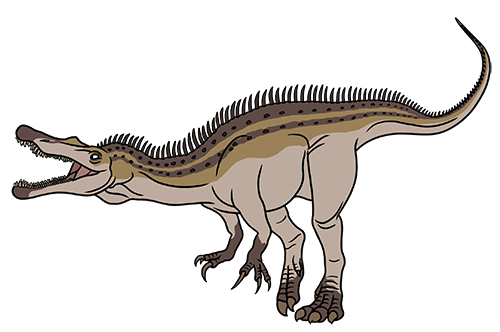Baryonyx
#7
by Kyle Morris on October 21, 2021Baryonyx was originally discovered in Surrey County, England, by fossil collector William J. Walker, in 1983. Other fossils of this dinosaur have been found in northern Spain. Named by paleontologists Alan Charig and Angela Milner in 1986, it gets its name meaning “heavy claw” from the large third claw on each of its hands.
This large piscivorous (fish-eating) theropod had an average length of about 30 feet, weighed 1–2 tons, and stood about 8–10 feet high.

Artist Rendering of Baryonyx
Baryonyx is a member of the spinosaur kind (or family). This group is characterized by having long and slender snouts. Their jaws were very different from other theropods and excellent for catching and holding onto fish. This type of snout is very similar to those of crocodilians such as alligators or crocodiles. They also had relatively long arms with large, curved claws on the end of each of their three fingers, which likely aided in grasping slippery fish.
The epic Beowulf describes a dragon with short arms (in proportion to the rest of its body) and a heavy claw. Also, the events of this account took place in Europe, making it quite possible that the creature being described was indeed a Baryonyx or perhaps inspired by one.
Did you know that dinosaurs would have been on the ark since God brought two representatives of each kind of land-dependent animal (seven of some) to Noah? This would include two representatives of the spinosaur kind. Therefore, it is entirely possible and likely that some dinosaurs lived even up to modern times. And it is especially possible when you consider all of the dragon legends found around the world, even until the 20th century. Many describe animals very similar to dinosaurs and other extinct reptiles.
October is “dinosaur month!” Every weekday of this month, you can come back to our Kids site to read about my 20 favorite dinosaurs. I hope you’ll join me!
- © 2025 Answers in Genesis
- Privacy Policy
- Contact
- About
